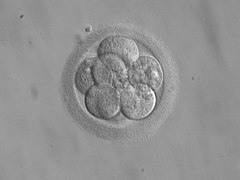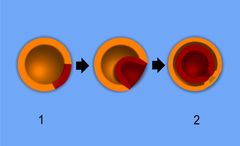ผลต่างระหว่างรุ่นของ "คัพภวิทยา"
ล r2.7.2) (โรบอต เพิ่ม: war:Embryolohiya |
Nullzerobot (คุย | ส่วนร่วม) ล เก็บกวาด |
||
| บรรทัด 20: | บรรทัด 20: | ||
<!-- |
<!-- |
||
== History == |
== History == |
||
With a very long history, embryology is a subject that has engaged the minds of some of the most brilliant and original biological thinkers and experimentalists. |
With a very long history, embryology is a subject that has engaged the minds of some of the most brilliant and original biological thinkers and experimentalists. |
||
[[ไฟล์:Haeckel drawings.jpg|150px|right|Ernst Haeckel embryo drawings]] |
[[ไฟล์:Haeckel drawings.jpg|150px|right|Ernst Haeckel embryo drawings]] |
||
In modern times, these include [[Gavin de Beer]], [[Charles Darwin]], [[Ernst Haeckel]], [[J.B.S. Haldane]], and [[Joseph Needham]], while much early embryology came from the work of [[Aristotle]] and the great [[Italy|Italian]] anatomists: [[Aldrovandi]], [[Aranzio]], [[Leonardo da Vinci]], [[Marcello Malpighi]], [[Gabriele Falloppia]], [[Girolamo Cardano]], [[Emilio Parisano]], [[Fortunio Liceti]], [[Stefano Lorenzini]], [[Spallanzani]], [[Enrico Sertoli]], [[Mauro Rusconi]], etc.<ref>http://www.ijdb.ehu.es/fullaccess/fulltext.0009/ft515.pdf Massimo De Felici, Gregorio Siracus, ''The rise of embryology in Italy: from the Renaissance to the early 20th Century,'' Int. J. Dev. Biol. 44: 515-521 (2000) </ref> Other important contributors include [[William Harvey]], [[Kaspar Friedrich Wolff]], [[Pander]], [[Karl Ernst von Baer]], and [[August Weismann]]. |
In modern times, these include [[Gavin de Beer]], [[Charles Darwin]], [[Ernst Haeckel]], [[J.B.S. Haldane]], and [[Joseph Needham]], while much early embryology came from the work of [[Aristotle]] and the great [[Italy|Italian]] anatomists: [[Aldrovandi]], [[Aranzio]], [[Leonardo da Vinci]], [[Marcello Malpighi]], [[Gabriele Falloppia]], [[Girolamo Cardano]], [[Emilio Parisano]], [[Fortunio Liceti]], [[Stefano Lorenzini]], [[Spallanzani]], [[Enrico Sertoli]], [[Mauro Rusconi]], etc.<ref>http://www.ijdb.ehu.es/fullaccess/fulltext.0009/ft515.pdf Massimo De Felici, Gregorio Siracus, ''The rise of embryology in Italy: from the Renaissance to the early 20th Century,'' Int. J. Dev. Biol. 44: 515-521 (2000) </ref> Other important contributors include [[William Harvey]], [[Kaspar Friedrich Wolff]], [[Pander]], [[Karl Ernst von Baer]], and [[August Weismann]]. |
||
[[ไฟล์:10dayMouseEmb.jpg|thumb|150px|right|Histological film 10 day mouse embryo]] |
[[ไฟล์:10dayMouseEmb.jpg|thumb|150px|right|Histological film 10 day mouse embryo]] |
||
| บรรทัด 57: | บรรทัด 57: | ||
{{เริ่มอ้างอิง}} |
{{เริ่มอ้างอิง}} |
||
* [http://embryology.med.unsw.edu.au/ UNSW Embryology] Large resource of information and media |
* [http://embryology.med.unsw.edu.au/ UNSW Embryology] Large resource of information and media |
||
* [http://www2.merriam-webster.com/cgi-bin/mwmednlm?book=Medical&va=embryo Definition of embryo according to Webster] |
* [http://www2.merriam-webster.com/cgi-bin/mwmednlm?book=Medical&va=embryo Definition of embryo according to Webster] |
||
* Scott F. Gilbert. ''Developmental Biology''. Sinauer, 2003. ISBN 0-87893-258-5. |
* Scott F. Gilbert. ''Developmental Biology''. Sinauer, 2003. ISBN 0-87893-258-5. |
||
* Lewis Wolpert. ''Principles of Development''. Oxford University Press, 2006. ISBN 0-19-927536-X. |
* Lewis Wolpert. ''Principles of Development''. Oxford University Press, 2006. ISBN 0-19-927536-X. |
||
| บรรทัด 70: | บรรทัด 70: | ||
{{คอมมอนส์-หมวดหมู่|Embryology}} |
{{คอมมอนส์-หมวดหมู่|Embryology}} |
||
[[หมวดหมู่:คัพภวิทยา| |
[[หมวดหมู่:คัพภวิทยา|คัพภวิทยา]] |
||
[[ar:علم الأجنة]] |
[[ar:علم الأجنة]] |
||
รุ่นแก้ไขเมื่อ 13:09, 30 มกราคม 2556



คัพภวิทยา หรือ วิทยาเอ็มบริโอ (อังกฤษ: Embryology) เป็นการศึกษาการเจริญของเอ็มบริโอ เอ็มบริโอคือขั้นหนึ่งของการเจริญของสิ่งมีชีวิตก่อนคลอดหรือออกจากไข่ หรือในพืชคือในระยะก่อนการงอก (germination)
คัพภวิทยาหมายถึงการเจริญของไข่ที่ได้รับการผสมแล้ว (ไซโกต) และมีการเปลี่ยนแปลงไปเป็นเนื้อเยื่อและอวัยวะต่างๆ หลังจากระยะแยก (cleavage) เซลล์ที่กำลังแบ่งตัว หรือมอรูลา (morula) จะกลายมาเป็นลูกบอลกลวง หรือบลาสตูลา (blastula) ซึ่งมีการเจริญของรูหรือช่องที่ปลายด้านหนึ่ง
ในสัตว์ บลาสตูลาจะมีการเจริญแบ่งได้ออกเป็น 2 ทาง ทำให้สามารถแบ่งสัตว์ในอาณาจักรสัตว์ออกเป็น 2 ประเภท ประเภทแรกคือหากมีการเจริญของรูในบลาสตูลา (บลาสโตพอร์ (blastopore)) กลายเป็นปากของสัตว์ จะเรียกว่าพวกโพรโตสโตม (protostome) แต่หากรูนั้นเจริญเป็นทวารหนัก จะเรียกว่าพวกดิวเทอโรสโตม (deuterostome) สัตว์พวกโพรโตสโตมได้แก่สัตว์ไม่มีกระดูกสันหลัง เช่น แมลง หนอน และพวกหอยกับปลาหมึก ในขณะที่พวกดิวเทอโรสโตมได้แก่สัตว์ที่วิวัฒนาการสูงเช่นสัตว์มีกระดูกสันหลัง (vertebrates) บลาสตูลาจะเปลี่ยนแปลงไปเป็นโครงสร้างที่เรียกว่า แกสตรูลา (gastrula)

แกสตรูลาและบลาสโตพอร์จะเจริญไปเป็นชั้นต่างๆ 3 ชั้น (germ layers) ซึ่งเป็นต้นกำเนิดของอวัยวะและเนื้อเยื่อในร่างกายทั้งหมด
- ชั้นในสุด หรือ เอนโดเดิร์ม (endoderm) เจริญไปเป็นอวัยวะในทางเดินอาหาร ปอด และกระเพาะปัสสาวะ
- ชั้นกลาง หรือ เมโซเดิร์ม (mesoderm) เจริญไปเป็นกล้ามเนื้อ โครงกระดูก และระบบเลือด
- ชั้นนอกสุด หรือ เอ็กโทเดิร์ม (ectoderm) เจริญไปเป็นระบบประสาทและผิวหนัง
สำหรับในมนุษย์ เอ็มบริโอหมายถึงกลุ่มเซลล์ที่กำลังแบ่งตัวรูปทรงกลมจากระยะที่ไซโกตฝังตัวอยู่ในผนังมดลูกจนกระทั่งถึงสิ้นสุดสัปดาห์ที่ 8 หลังจากตั้งครรภ์ หลังจากสัปดาห์ที่ 8 จะเรียกตัวอ่อนของมนุษย์ว่าทารกในครรภ์ (fetus) เอ็มบริโอของสัตว์หลายชนิดจะมีลักษณะคล้ายกับสัตว์ชนิดอื่นๆ ในระยะการเจริญช่วงแรกๆ เหตุผลที่มีความคล้ายคลึงกันนั้นเนื่องจากสิ่งมีชีวิตมีการปรับตัวในสิ่งแวดล้อมของการตั้งครรภ์ ความคล้ายคลึงกันในสิ่งมีชีวิตแต่ละชนิดเรียกว่า โครงสร้างกำเนิดต่างกัน (analogous structures) ซึ่งเป็นโครงสร้างที่ทำหน้าที่หรือกลไกเหมือนกันแต่วิวัฒนาการมาจากคนละส่วนกัน
อ้างอิง
- UNSW Embryology Large resource of information and media
- Definition of embryo according to Webster
- Scott F. Gilbert. Developmental Biology. Sinauer, 2003. ISBN 0-87893-258-5.
- Lewis Wolpert. Principles of Development. Oxford University Press, 2006. ISBN 0-19-927536-X.
แหล่งข้อมูลอื่น
- Embryo Research UK philosophy and ethics website discussing the ethics of embryology
- Human embryo research Canadian website covering the ethics of human embryo research
- University of Indiana's Human Embryology Animations
- The Developing Human (Keith L.Moore) http://www.youtube.com/watch?v=Rb0uZefwQnc
